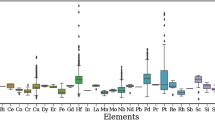Abstract
We develop a phenomenological model of irreversible deformation of dislocation nature for shape-memory materials based on iron. The abnormal decrease in the yield stress in the vicinity of the temperature of onset of the direct martensitic transformation and residual microstresses depending on the history of force and temperature loads are taken into account. The model is applied to the results of thermomechanical and alternating cyclic tests. The loading surface is constructed and its transformations are described. The numerical results are compared with the experimental data for a shape-memory alloy based on iron with 9% Cr, 5% Ni, 14% Mn, and 6% Si. It is shown that the proposed model is applicable to the description of the deformation behavior of the material. The obtained results can be used for the description of the thermomechanical behavior of elements of shape-memory mechanisms and structures.
Similar content being viewed by others
REFERENCES
K. Tanaka, T. Hayashi, F. Nishimura, and H. Tobushi, “Hysteretic behavior in an Fe-Cr-Ni-Si polycrystalline shape-memory alloy during thermomechanical cyclic loading,” J. Mater. Eng. Perform., 3, No.2, 135–143 (1995).
R. Abeyaratne and S.-J. Kim, “Cyclic effects in shape-memory alloy: a one-dimensional continuum model,” Int. J. Solids Struct., 34, No.25, 3273–3289 (1997).
S. B. Batdorf and B. Budiansky, A Mathematical Theory of Plasticity Based on the Concept of Slip, Technical Note No. 1871, NACA (1949).
Ya. F. Andrusik and K. N. Rusinko, “Plastic deformation of hardening materials under cyclic loads within the framework of the synthetic theory of plasticity,” Mekh. Tverd. Tela., No. 3, 76–85 (1999).
I. M. Goliboroda and K. N. Rusinko, “Description of reversible deformation caused by martensitic transformations,” Probl. Mitsn., No. 8, 68–75 (1995).
I. M. Goliboroda and K. N. Rusinko, “A phenomenological model of nonlinear deformation of polycrystalline bodies caused by martensitic transformations,” Zh. Tekhn. Fiz., No. 11, 124–135 (1996).
I. M. Holyboroda, “Description of the mutual influence of the processes of deformation of defect and martensitic nature within the framework of the synthetic model,” Probl. Mitsn., No. 6, 124–131 (1998).
I. Goliboroda, K. Rusinko, and K. Tanaka, “Description of a Fe-based shape memory alloy thermomechanical behavior in terms of the synthetic model,” Comp. Mater. Sci., No. 13, 218–226 (1999).
I. M. Holyboroda, “Description of the irreversible deformation, elastic deformation, and deformation of thermal expansion of a polycrystal under the conditions of reversible martensitic transformation,” Mat. Metod. Fiz.-Mekh. Polya, 44, No.1, 114–123 (2001).
V. A. Likhachev and V. G. Malinin, Structural-Analytic Theory of Strength [in Russian], Nauka, St. Petersburg (1993).
I. M. Goliboroda, “Influence of temperature effects on the deformation of creep,” Vestn. L'vov. Politekh. Inst. Ser. Din. Proch. Mash. Prib., No. 210, 33–34 (1987).
A. A. Il'yushin, Plasticity Theory [in Russian], Nauka, Moscow (1963).
K. N. Rusinko and I. M. Goliboroda, “Influence of temperature hardening and aftereffect on the creep of metals with cubic three-dimensional lattice,” Probl. Prochn., No. 11, 58–62 (1988).
E. Orowan, “The creep of metals,” J. West Scotland Iron Steel Inst., 54, 45–59 (1946).
Yu. N. Rabotnov, Creep of Structural Elements [in Russian], Nauka, Moscow (1966).
K. N. Rusinko, Theory of Plasticity and Nonstationary Creep [in Russian], Vyshcha Shkola, Lviv (1981).
F. Nishimura and K. Tanaka, “Phenomenological analysis of thermomechanical training in a Fe-based shape memory alloy,” Comp. Mater. Sci., No. 12, 6–38 (1998).
K. Tanaka, F. Nishimura, H. Tobushi, E. R. Oberaigner, and F. D. Fischer, “Thermomechanical behavior of a Fe-based shape memory alloy: transformation conditions and hysteresis,” J. Phys. IV, 5(8), 463–468 (1995).
I. M. Holyboroda, “Nonlinear deformation of polycrystalline shape-memory materials based on iron in terms of a phenomenological theory,” Dyn. Mitsn. Proekt. Mash. Pryl., No. 483, 30–40 (2004).
Author information
Authors and Affiliations
Additional information
__________
Translated from Fizyko-Khimichna Mekhanika Materialiv, Vol. 41, No. 2, pp. 23–32, March–April, 2005.
Rights and permissions
About this article
Cite this article
Holyboroda, I.M. Description of Deformation of Shape-Memory Materials by Thermomechanical and Alternating Loads. Mater Sci 41, 158–169 (2005). https://doi.org/10.1007/s11003-005-0146-2
Received:
Issue Date:
DOI: https://doi.org/10.1007/s11003-005-0146-2




